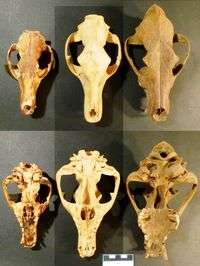Bigger and brainier: did dingoes kill thylacines?

Direct attacks by introduced dingoes may have led to the extinction on the Australian mainland of the iconic marsupial predator, the thylacine, a new study suggests.
A comparison of museum specimens has found that thylacines on mainland Australia were smaller than those that persisted into modern times in Tasmania, and significantly smaller than dingoes. The last known Tasmanian thylacine died in 1936.
Measurements of the head size and thickness of limb bones of the semi-fossilised remains of thylacines and dingoes from caves in Western Australia have revealed that, on average, dingoes were larger than thylacines.
“In particular, dingoes were almost twice as large as female thylacines, which were not much bigger than a fox,” says ecologist Dr Mike Letnic, an ARC Future Fellow in the UNSW School of Biological, Earth and Environmental Sciences, who led the study with colleagues at the University of Sydney. The findings are published in the journal PLoS One.
There has long been debate as to what caused the extinction of the thylacine from mainland Australia, Dr Letnic notes. Because Tasmanian thylacines were much larger than dingoes, direct confrontation between the two species was discarded as a hypothesis for the thylacine decline.
Another hypothesis is that competition between the two species may have been the cause: however, competition is not thought to be a strong driver of extinction. More recently, some authors have suggested that people caused the extinction of the thylacine through direct hunting or suppression of prey.
“We were aware of old reports that mainland thylacines were smaller than Tasmanian ones,” says Letnic. “Modern ecological studies show that larger predators frequently kill smaller predators, so we decided to test the hunch that dingoes were actually larger than thylacines and caused their extinction by killing them in direct confrontations.
“We also measured the brain size of both species and found that dingoes also had much bigger brains than thylacines, so they may have outwitted them, too.”
Dingoes appear to have had a dramatic impact on the ecology of Australia when they first arrived between 3,500-5,000 years ago, probably introduced by human seafarers, and likely also caused the extinction of the Tasmanian devil from mainland Australia (devils are still found in Tasmania, which does not have dingoes).
“However, recent studies suggest that dingoes now play an integral role in maintaining healthy balanced ecosystems by limiting the populations of herbivores and smaller predators, a role that was once filled by the thylacine,” says Dr Letnic.
Provided by University of New South Wales




















